Paska Easter Bread
Traditional Paska Bread makes a sweet and delightful addition to your Easter table. This easy-to-make sweet bread uses pantry staple ingredients to make a soft and tender loaf of bread. Studded with golden raisins and a braided top, this delicious bread is the perfect addition to your Easter celebrations.

My mom’s side of the family is Italian and that is where I get the majority of my Easter recipes; things like Italian Easter Bread, Pigu, Bacon and Cheese Easter Bread, and Italian Easter Pie. On my dad’s side of the family, my grandmother is Polish and my grandfather was Irish. I don’t know as much about those food traditions, but I’m trying to take the opportunity each year to learn more.
A while ago, my grandma shared this recipe for Paska bread with me. She said she got it years ago from a woman she began chatting with at a department store. They talked about recipes and the woman took down my grandma’s address and said she would send her the family’s Paska recipe. Lo and behold, a few days later, a handwritten recipe showed up in my grandma’s mailbox. As someone who loves to talk about food and share recipes, I just love that story!
What is Paska?
When I first set out to make the recipe I wanted to learn a little more about where it originated and how it’s served.
Paska is a traditional Easter bread from Ukraine and eastern Europe. In Russia, this sweet, eggy bread is called Kulich. It’s most often made in the spring to celebrate Easter. The word Paska translates to “Easter” in most eastern European cultures (except Finland where it’s a 4-letter word).
Traditionally, paska bread is made and taken to church Easter morning to be blessed and then brought home to be enjoyed with Easter meals.

Ingredients for Paska Bread
This Paska bread recipe is a traditional brioche dough recipe, enriched with egg yolks and sugar, then studded with golden raisins and baked up. The raisins are optional and you could definitely omit them if you’d like.
- Whole Milk: The milk gives this bread a softer crust and a rich texture.
- Instant Yeast: Helps the bread rise to towering heights.
- Sugar: Sweetens the bread as well as feeds the yeast to help the dough grow.
- Butter: Gives the dough a softer finish similar to a brioche.
- Eggs: Binds the ingredients together while also lending a little color to this bread.
- Vanilla + Salt: All the flavor!
- Flour: I use all-purpose flour in this recipe.
- Raisins: These add a little sweetness and are totally optional- my mom would omit them!
- Egg wash: Made from mixing an egg with water to glaze the top before baking.
- Coarse sugar: For sprinkling on top, optional but highly recommended.
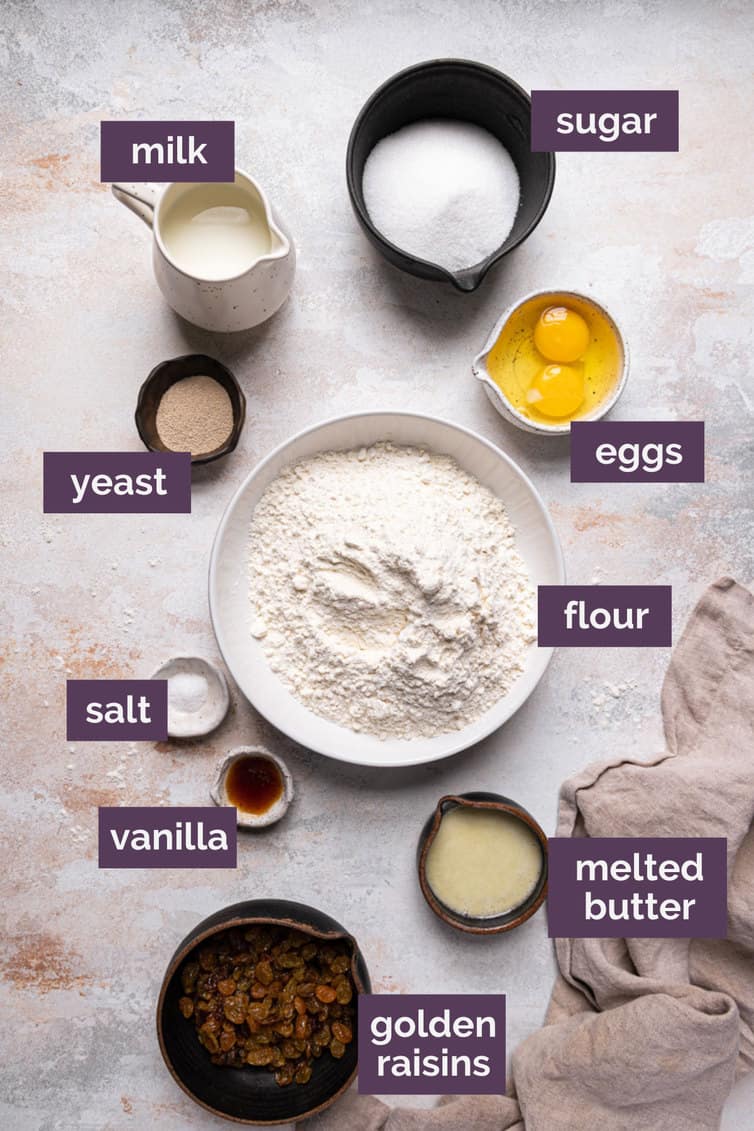
How to Make Paska Bread
I’m breaking this down into steps to walk you through the process; first, we make the dough, then shape the loaf, and bake the bread. Let’s do it!
Save This Recipe
Make the Bread Dough
- Activate the yeast: Warm the milk to a temperature between 100°F and 110°F (usually 30 seconds in the microwave should do the trick). Pour the warmed milk into a mixing bowl and sprinkle the yeast over top and let sit for 5 to 10 minutes, until foamy.

- Add liquid ingredients: Add sugar, butter, eggs, and vanilla to the bowl. Stir to combine.
- Make a shaggy dough: Add the flour and the salt into the bowl. Stir with a wooden spoon until a shaggy dough forms. If using, add the golden raisins.
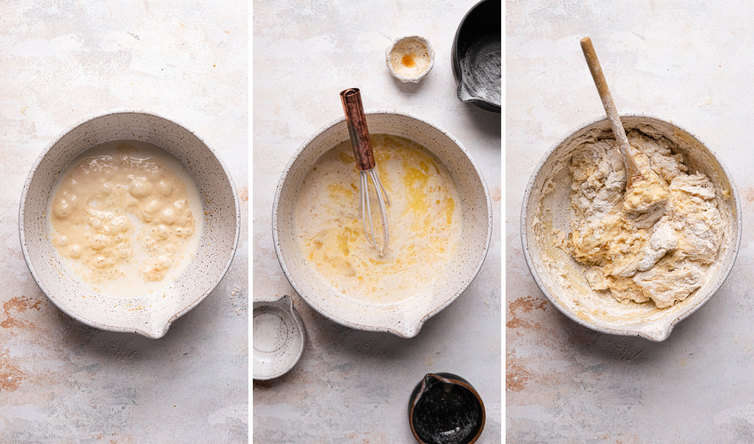
- Knead the dough: Using the dough hook, knead on medium-low speed until a smooth, shiny ball of dough is formed, 3 to 6 minutes, adding additional flour as necessary. (You can also knead by hand until a smooth ball is formed.)
- Let dough rise: Place the dough in a greased bowl and cover with plastic wrap. Place in a warm, draft0free spot until double in size, 1 to 2 hours.

Form and Shape the Dough
- Divide the dough: Punch the dough down and remove it from the bowl to a clean work area. Remove one-quarter of the dough and set aside.
- Shape the base: Form the large piece of dough into a ball and place in a 9-inch round cake pan or a springform pan.
- Braid the dough: Divide the remaining dough into three pieces and roll them each into 20-inch strands. Braid the three strands together for one long braid.
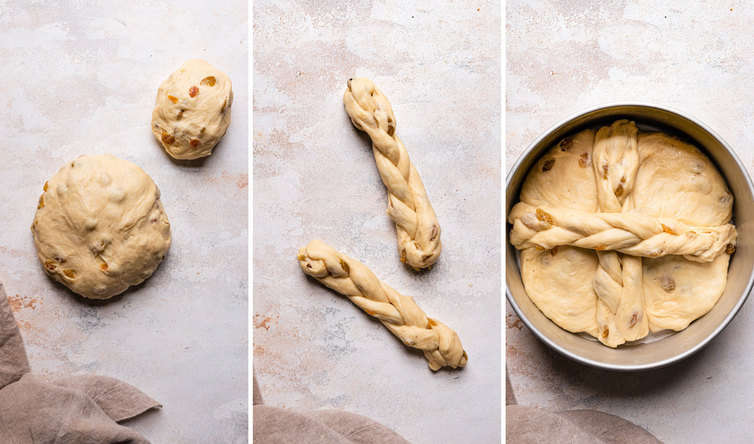
- Top the dough: Divide the braid in half and use it to form a cross over the top of the large ball of dough in the pan. Alternately you can wrap the braid in one length around the inside edge of the pan.
- Allow to rise: Cover lightly with plastic wrap and let rise until puffy and nearly double in size, 45 to 60 minutes.
Bake the Paska Bread
- Set the oven: Preheat the oven to 400°F.
- Make the egg wash: Whisk together the egg and water, then brush evenly all over the top of the dough and sprinkle with sugar.
- Bake the paska: Bake for 15 minutes, then reduce the oven temperature to 350°F and bake for an additional 25 to 30 minutes, until golden brown and an instant-read thermometer registers to 190°F. You can tent the pan with aluminum foil if it is browning too quickly.
- Cool the bread: Remove from the oven, turn the bread out of the pan, and place on a wire rack to cool completely.

Frosting and Glaze
We enjoy this paska bread recipe as is, but if you are looking to sweeten it up even more, try topping the bread with a simple powdered sugar and milk glaze or one of the following:
- Cream cheese frosting
- Vanilla buttercream frosting
- 7 minute frosting
- Orange glaze from my cranberry pound cake
Toppings and Mix-ins
- Traditional topping: Paska is often eaten with hrudka which is a bland, sweet custard similar to cheese.
- Other Toppings: Aside from frosting or a glaze you can top this sweet bread with sprinkles!
- Mix-ins: Chocolate chips, raisins or craisins, or candied fruits mix beautifully in the dough.
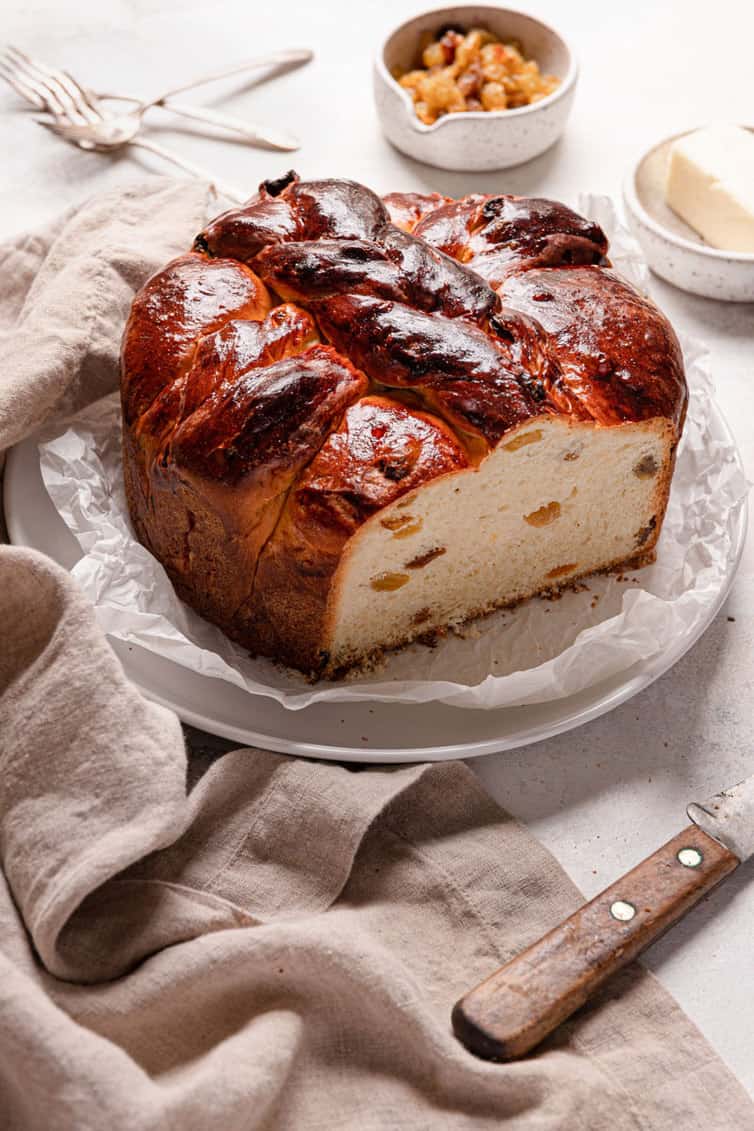
Storing, Freezing, Making Ahead
- Storing: Keep cooled paska bread in an air-tight container at room temperature for up to 3 days.
- Freezing: Wrap the cooled paska bread in a tight coat of plastic wrap followed by a layer of foil. Then store in a freezer-safe bag for up to 1 month. Thaw in the fridge overnight.
- Making ahead: You can make this 1 day in advance of serving it, to keep it as fresh as possible. Once cooled, wrap it tightly in two layers of plastic wrap and keep it at room temperature until serving.
- Leftovers: If you don’t want to freeze any of the leftover paska I would suggest slicing and using the bread in French toast or a bread pudding.

Other Delicious Easter Recipes
- Italian Easter Pie Recipe
- Bacon and Cheese Easter Bread
- Italian Easter Bread
- Koulourakia: Greek Easter Cookies
- Tsoureki: Greek Easter Bread
Paska Bread
This Easter, delight your family with a loaf of this sweet Paska Bread. Made with pantry staple ingredients, this raisin studded bread is sure to be a show-stopper! Slather it with butter, a sweet glaze, or homemade icing for a delicious treat!
If you make this Paska Bread recipe and love it, remember to stop back and give it a 5-star rating - it helps others find the recipe! ❤️️
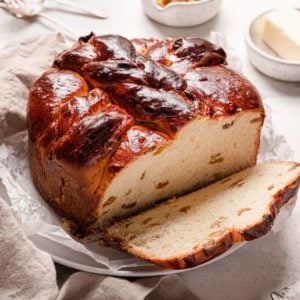
Paska Easter Bread
Ingredients
- 1 cup (240 ml) whole milk, warmed to 110 degrees F
- 2¼ teaspoons (2.25 teaspoons) instant yeast, 0.25-ounce packet
- ½ cup (99 g) granulated sugar
- ¼ cup (57 g) unsalted butter, melted and cooled to room temperature
- 2 eggs
- 1½ teaspoons (1.5 teaspoons) vanilla extract
- 4 cups (480 g) all-purpose flour
- ½ teaspoon (0.5 teaspoon) salt
- 1 cup (160 g) golden raisins, optional
For the Egg Wash:
- 1 egg
- 2 tablespoons water
- Coarse sugar, for sprinkling, optional
Instructions
- Warm the milk to between 100 to 110 degrees F (usually 30 seconds in the microwave does the trick!) and pour into a mixing bowl. Sprinkle the yeast over top and let sit for 5 to 10 minutes, until foamy.
- Add the sugar, butter, eggs, and vanilla extract, and stir to combine.
- Add the flour and the salt and stir with a wooden spoon until a shaggy dough forms. Add the golden raisins then, using the dough hook, knead on medium-low speed until a smooth, shiny ball of dough is formed, 3 to 6 minutes, adding additional flour as necessary. (You can also knead by hand until smooth ball is formed.) Place the dough in a greased bowl and cover with plastic wrap. Place in a warm, draft-free spot until doubled in size, 1 to 2 hours (rise time will depend on temperature and humidity in your kitchen).
- Punch dough down and remove from the bowl to a clean work area. Remove one-quarter of the dough and set aside. Form the large piece of dough into a ball and place in a 9-inch round cake pan or springform pan.
- Divide the remaining piece of dough into three pieces and roll them each out into a 20-inch strand. Braid the three strands together for one long braid. Divide the braid in half and use it to form a cross over the top of the large ball of dough in the pan. (Alternately, you can wrap the braid in one length around the inside edge of the pan.)
- Cover lightly with plastic wrap and let rise until puffy and nearly doubled in size, 45 to 60 minutes.
- Preheat oven to 400 degrees F.
- Whisk together the egg and water, then brush evenly all over the top of the dough and sprinkle with sugar, if desired.
- Bake for 15 minutes, then reduce the oven temperature to 350 degrees F and bake for an additional 25 to 30 minutes, until golden brown and an instant-read thermometer registers 190 degrees F. You can tent the pan with aluminum foil if it is browning too quickly. Remove from the oven, turn the bread out of the pan, and place it on a wire rack to cool completely.
Notes
- Equipment: 9-inch round cake pan or springform pan.
- Golden Raisins: You can substitute regular raisins, other chopped dried fruit, or omit entirely.
- Doubling Recipe: This recipe is easily doubled if you'd like to make two loaves - one for eating and one for gifting (or for your freezer!).
- Storing: Keep cooled paska bread in an air-tight container at room temperature for up to 3 days.
- Freezing: Wrap the cooled paska bread in a tight coat of plastic wrap followed by a layer of foil. Then store in a freezer-safe bag for up to 1 month. Thaw in the fridge overnight.
- Making ahead: You can make this 1 day in advance of serving it, to keep it as fresh as possible. Once cooled, wrap it tightly in two layers of plastic wrap and keep it at room temperature until serving.
- Leftovers: If you don't want to freeze any of the leftover paska I would suggest slicing and using the bread in French toast or a bread pudding.
Did you make this recipe?
Leave a review below, then snap a picture and tag @thebrowneyedbaker on Instagram so I can see it!
Photography by Dee Frances






I have never heard of Paska bread before but so glad to have found it now! Looks like quite a treat.
I have been needing a new bread recipe! I am very excited about this!
I grew up with this Paska bread for Easter. My Grandparents came over from the Ukraine as Mennonite Refugees. The ladies in the village where they came from originally would stack their egg shells on the fence posts as a quiet boast of how rich they were and could add many eggs to their dough. Our Paska is still baked in tin cans so they are cylindrical and have a muffin top. This top is then decorated with icing glaze topped with small jelly eggs, marshmellow rabbits, coconut or whatever is Easterish decor! Every child gets to decorate his own and for their friends! Grandma (92 yrs) has the Great-Grandkids come and bring their Paska for her to decorate! The bread is sliced from the bottom up in circles to be toasted and eaten with butter. It was always too dry to just eat without toasting after the first day out of the oven. BTW: I use 1 TBSP yeast for a Cake.
There is nothing hard about making them and we do some with raisins and without. Try Craisins!
Pinning this to try sometime. Looks amazing! Thanks for sharing!
My husband’s Baba used to make this but also added orange zest – I’m wondering how much to add. Maybe 1/4 cup for whole recipe?
For my Italian Easter Bread (https://www.browneyedbaker.com/2012/04/04/italian-easter-bread-recipe/), which yields about the same amount of dough, I use the zest and juice of 2 oranges.
The texture looks amazing! Everything looks so gorgeous!
Being of Ukrainian descent I appreciate you posting this recipe!! Your Paska looks beautiful!!
Wow, I’m half Polish & half Italian too! I KNEW I liked you! My brother will be thrilled to have this Easter Bread recipe because years ago we tried to make it from a relative’s “hand full of this and spoonful of that” type directions, and we made an Easter brick!
I did the same thing! My Polish Grandma spoke only broken English. Between that and trying to gauge how much flour was in her hands, my attempt failed. It was one heavy brick. I’m looking forward to trying this.
Hi, my maternal grandmother was Polish (off the boat), and my maternal grandfather was of Irish descent (2nd generation) like your dad’s side. I noticed your Italian Easter pie that was traditional to break Easter fast on the Saturday before Easter. The Polish tradition was to not break fast until after Church on Easter Sunday, so we have Easter breakfast/brunch which includes kielbasa, lots of eggs, and baked beans (which I think came from the Irish side of the family). We have a sweet bread tradition – pecan rolls – but I don’t think it has anything to do with Paska, I don’t remember my grandmother making anything like that. Probably my favorite Polish dish – one I crave and have to make every so often is Kapusta.
Such a lovely bread! I love that it’s full of juicy raisins.
I love that you posted this! It’s the bread my grandmother has always made for Christmas and Easter. I’ll be making my batch on Friday. Half the dough becomes poppyseed roll and the other half is made into loaves (usually with a little dough-cross pressed into the top of each one for Easter). I love that you use the golden raisins, just like we do – regular raisins just aren’t the same in this bread!
Looks fantastic.. nice clicks too !!
My grandmother was Polish, and she made a holiday bread that was very similar for both Christmas and Easter. Our family just called it “homemade bread,” and I haven’t come across the name paska, although I’ve tried to uncover the origins of her recipe. Fortunately, my aunt wrote up a recipe while my grandmother was still alive, and I recently simplified or “modernized” it if you will by making it more precise. When the women in my family have tried to make it in the past, they’ve had to cross fingers and pray for good results because the bread was always a 50-50 chance of success. One funny thing is that my grandma’s recipe also called for the “cake” type yeast which I never find. And, my grandma was from Pittsburgh btw. Anyway, here’s a link to my version of her bread:
http://www.aminglingoftastes.com/2012/12/polish-holiday-sweet-bread.html
Aw, I love it! Thanks for sharing your link!
My polish grandmother makes this every year! I always request a loaf (or two) to take home with me. I can’t get enough. I might attempt this recipe to see how it compares to hers. Thanks for sharing!
absolutely gorgeous bread!
Yummy! I wlll try this. But like the other ladies – I was wondering about the 2 cakes of yeast?? And what would the substitute be??
Hi Lianne, Cakes of yeast is the fresh version of yeast and usually found in the refrigerated section of the supermarket. I have the measurements in the ingredient list above for substituting active dry yeast.
Wow, this bread looks amazing, and reading the ingredients list, it has to be good! I love the sunny, brightness that the golden raisins give it.
My father-in-law is Polish and I know he would love it if I made him this bread. Thanks for the recipe, Michelle!
My grandmother who was from Poland made this every year. She always made a few loaves and took one to be blessed in the Easter basket on Holy Saturday. Thanks for posting and bringing back some good memories. I may try to make the bread for Easter Sunday.
My Busia (Polish for grandmother)use to make a variation of this recipe. The problem was…she did not have a recipe. She made all her breads and pastries by “feel” and they always tasted amazing! Cannot wait to try this recipe!
I would hide myself away with a loaf of this bread and a stick of cold, sweet butter.
Definitely Eastern European/Orthodox.
Thanks for the recipe. My husband is Orthodox and I may just be nice enough to make him Paska for Easter since there is no way any bakery will have it on May 5th which is Orthodox Easter this year.
I asked my dear friend Joanna, who is originally from Poland, and she said that they make something similar in a bundt cake pan and call it “babka”, and they coat it in confectioner’s sugar.
This looks delicious.
What is 2 cakes fresh yeast? What would I substitute and where can I buy it?
Yeast comes in three forms – fresh (called cakes), active dry and instant. The fresh yeast is sold in the refrigerated section of most supermarkets. See the ingredient list above for the active dry substitution.
May i know what is 2 cakes fresh yeast?
And you mentioned substitute 200ml warm milk and yeast -> how much yeast to add?
Thanks :)
Haopy Easter Holidays!
Fresh yeast is a type of yeast (vs. active dry or instant) and can be found in the refrigerated section of the supermarket. You don’t substitute milk for the yeast; milk is part of the ingredients of the recipe. See the ingredient list above for the active dry yeast substitution.
My Husband is Polish. I have to ask him about this bread, if he knows it. I might make it for him as a surprise this weekend! Thank you for sharing!
Wow! I’m Polish and I’ve never had this sort of bread on Easter. Google shows me that it’s a regional dish made predominantly in the Eastern provinces, especially in the Orthodox communities (the fact that it doesn’t have a Polish wikipedia entry is a bit telling). It’s definitely more of a Russian/Ukrainian specialty. The majority of Poles celebrate Easter with a yeast babka (which is more or less the same dough as paska, but baked in a bundt pan), or mazurek, or cheesecake, or maybe even a paskha (a tasty dessert made of curd cheese, sugar, vanilla, yolks, nuts, and all sorts of dried fruit and mixed peel). Paskha-the-dessert has Russian origins too, but somehow it gained much more popularity than paska-the-bread ;)
I got my recipe from my mother-in-law whose mother was directly from Poland – what area I am not sure. Mine is made the bread then there is a cheese “dough” that include yeast and flour and strong Cheddar cheese rolled into the bread dough – we love this. Instant cheese sandwich or better yet a delightful ham and cheese sandwich – anyone else have this type ??
Thanks Michelle. I may try this and let you know. I grew up with this type of babka that my grandma’s neighbor used to make for Easter. Although they were shaped like a stand up cylinder.
Saw your comment about stand up cylinders. I had to laugh. My Grandmother used coffee cans too!
We call it Kulich where I’m from but regardless, there really are few things that compare to kulich (babka) for a Russian Easter celebration! A cylinder shape is almost mandatory in my household after watching ‘Gran and ‘Ma make these for so long in their bakery and seeing so many of the familiar cylinder-cakes in the stores, but I suppose if there’s no clean cans available a breadpan would totally work out.
I personally love a tiny bit of orange peel and some cardamom mixed in with mine, it brings things together so nicely. Put the dough in a well greased and floured coffee can and let heaven bake while getting some nice vanilla glaze ready.
Something that is really good to do is to soak some golden raisins in spiced rum with a touch of vanilla before folding them in the batter, it really brings out some nice flavors with the orange flavors. Craisins were also used to wonderful effect after a soaking in Triple Sec liqueur.
I Love bread!1 Of all kinds! This one is no exception, it looks so soft! With butter, right out of the oven, mmmm…!
Just one thing, how much is a cake of yeast?
In Portugal we have a traditionnal Easter bread called Folar de Páscoa, flavored with cinnamon and anise, and decorated with hard boiled eggs.
Hi Teresa, Cakes of yeast are sold in the refrigerated section of the supermarket. I believe they are 2 ounces.
I love golden raisins and this bread looks like something my Russian-Polish grandmother used to make! Love the story how you came to obtain the recipe!